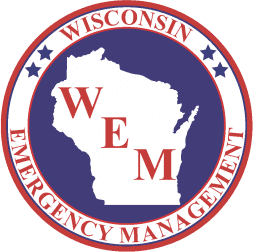Wisconsin Emergency Management/ State Emergency Response Commission (WEM/SERC) is responsible for implementing the federal Emergency Planning and Community Right-to-Know Act (EPCRA) also known as the Superfund Amendments and Reauthorization Act (SARA) of 1986 at the state and local levels. WEM/SERC has designated that each of the 72 counties in Wisconsin have Local Emergency Planning Committees (LEPCs) that are set up in accordance with the federal legislation and who are responsible for implementation of EPCRA at the county level. WEM/SERC further designated that the county emergency management director shall be a member of the LEPC to ensure continuity and coordination of emergency response planning.
WEM/SERC is also responsible for administering the Emergency Planning Grant that provides funding on a formula basis to county LEPCs for local planning and program administration and the Equipment Grant which provides matching funding for computer equipment and hazardous materials response equipment.
Under 1991 WI Act 104 the WEM/SERC is also responsible for contracting with eight regional hazardous materials response teams as well as providing hazardous materials response equipment funding, on a matching basis, to the designated county hazardous materials response teams.
Summary of Requirements for EPCRA and s. 323.60, Wis. Stats
Emergency Planning Notification – SECTION 302 and s. 323.60 Wis. Stats. , requires the owner or operator of a facility that has present any extremely hazardous substances (EHS), in amounts that equal or exceed the chemical-specific threshold planning quantity (TPQ), to notify WEM and the LEPC that the facility is subject to the planning provisions of the Act. This requirement must be done within 60 days of the EHS being present at the facility at or above the TPQ. In Wisconsin the facility would report using Form DMA 1003, Emergency Planning Notification Fee Statement. There is a one-time $1,080 planning fee also due within 60 days of the EHS being present at or above the TPQ. A 20% late payment surcharge is due if the fee is paid after 60 days. A facility is exempt from fee payment if the operator has less than 10 full time equivalent (FTE) employees (less than 20,000 paid hours annually) in the state.
Providing Emergency Planning Information – SECTION 303 and s. 323.60, Wis. Stats. , requires an owner/operator subject to Section 302 to provide the LEPC with the name, address, and telephone number of a facility representative “who will participate in the emergency planning process as the facility emergency coordinator.” Correspondence on business letterhead outlining responsibilities is acceptable. The county LEPC will then develop the off-site plan in cooperation with the facility. The facility must provide the LEPC with any information that is requested and necessary to develop the plan.
Emergency Release Notification – SECTION 304 and s. 323.60, Wis. Stats., requires the owner or operator of a facility to immediately provide verbal notification to the appropriate governmental entities (National Response Center at 800-424-8802, WEM at 800-943-0003, menu option #1, and appropriate LEPCs), that a release of a Comprehensive environmental Response Compensation and Liability Act (CERCLA) hazardous substance or EPCRA extremely hazardous substance (EHS) has occurred which meets or exceeds the listed reportable quantity (RQ), when the release goes off-site. This is commonly referred to as the federal substance release reporting law.
Wisconsin also has its own release reporting law under s. 292.11, Wis. Stats. The Wisconsin Department of Natural Resources (DNR) has authority over the law and it is commonly referred to as the DNR spill law. The law requires that the person who possesses or controls a hazardous substance which is discharged or who causes the discharge of a hazardous substance shall notify the department immediately of any discharge not exempted by law. In addition, those same persons must take the actions necessary to restore the environment to the extent practicable and minimize the harmful effects from the discharge to the air, lands or waters of this state. Chapter NR706, is the administrative rule that further defines notification requirements and spill reporting exemptions. To provide notification, call the state hotline at 1-800-943-0003, use menu option #1 for substance release reporting.
Material Safety Data Sheet (MSDS) or MSDS Chemical List Submission – SECTION 311 and s. 323.60, Wis. Stats., states that the owner or operator of a facility, required under the Occupational Safety and Health Act (OSHA) to prepare or have available a Material Safety Data Sheet (MSDS) for a hazardous chemical, must submit to WEM, LEPC, and the local fire department, an MSDS for each hazardous chemical OR an MSDS Chemical List, listing hazardous chemical grouped by hazard category, for each hazardous chemical present at a facility in quantities that equals or exceeds 10,000 pounds and for EHS that are present at a facility in quantities that equal or exceed 500 pounds or the TPQ, whichever is less.
Section 311 is not an annual reporting requirement. However, revised SDSs or SDS chemical lists must be provided to WEM, LEPC, and the local fire department within three months after the discovery of significant new information concerning the hazardous chemical or when a new hazardous chemical becomes present at the facility above the established levels.
The following link is a copy of the EPA guidance/clarification document. This document contains a crosswalk for reporting under the new 24 hazard classes required by EPA, as well as clarifications from EPA regarding reporting using safety data sheets (SDS).
Effective 1/1/2025, the EPCRA fees have been adjusted.
Administrative Code Chapter Affected: WEM 1 Fees (Revised)
Related to: Establishment of a fee payment structure for owners or operators of facilities with hazardous chemicals present, as directed by s. 323.60 (7), Stats.
Plain Language Analysis: Under § 323.60(7)(a) Stats., the Wisconsin Emergency Management Division (WEM) is required to promulgate rules necessary to implement EPCRA and to set fees at levels designed to fund WEM’s administrative expenses and grants awarded pursuant to s. 323.61, Stats. WEM promulgated Chapter WEM 1 to fulfill its obligations. These fees (Chapter WEM 1) were last updated in 2010. Inflation since 2010 has reached nearly 30% according to the US Bureau of Labor Statistics. Projections based on historic expenses for completing the statutorily-required tasks in s. 323.60(2) showed the fees collected were insufficient to continue funding the statewide program and grants to counties beyond the state fiscal year 2024.
The state legislature approved the EPCRA fees effective 1/1/2025 to account for 30% inflation.
See more information at https://docs.legis.wisconsin.gov/code/admin_code/wem/1
| Number of Chemicals | 1 | 2-10 | 11-100 | 101-200 | 201-300 | 301-400 | 401-500 | 501+ |
|---|---|---|---|---|---|---|---|---|
| Fee (< 100,000 lbs. cumulative) | $275 | $550 | $825 | $1,010 | $1,195 | $1,380 | $1,560 | $1,745 |
| Fee (≥ 100,000 lbs. cumulative) | $330 | $655 | $990 | $1,210 | $1,430 | $1,650 | $1,870 | $2,090 |
| Emergency Planning Notification | $1,080 |
|---|---|
| Temporary Construction | $35 |
| Batch Plant | $35 |
Toxic Chemical Release Reporting – SECTION 313 and s. 323.60(5)(d), Wis. Stats. , and Wisconsin Administrative Rule WEM 3 requires the owner/operator of a facility with Standard Industrial Codes (SIC) 20-39, public and private agencies, or SIC codes 10-13, who have 10 or more full- time equivalent employees at the facility, to report by July 1st annually; toxic chemicals used at the facility, equal to or in excess of 10,000 pounds for the preceding year; and listed toxic chemicals manufactured (including importing) or processed at the facility, equal to or in excess of 25,000 pounds for the preceding year. Information must be reported to U.S. Environmental Protection Agency (EPA) through their online reporting system “TRI-me”. To gain access to “TRI-me” a company must set up a user account through EPA’s Central Data Exchange (CDX). Refer to the EPA’s webpage on TRI to learn how to file the report.
EPCRA COMPLIANCE AND ENFORCEMENT PROGRAM
The Emergency Planning and Community Right-to-Know Act (EPCRA) – The Compliance Program staff offers technical assistance regarding the EPCRA requirements and compliance to facility owners/operators, LEPCs, County Emergency Management Directors, and other state and local agency staff. Assistance is provided to county LEPCs for outreach programs. Also educational materials and presentations are available for business and industry, highlighting program requirements. Compliance staff also conducts compliance reviews to identify potentially noncompliant facilities and conduct investigations. An EPCRA Booklet on the requirements of federal and state EPCRA law is available for facilities and LEPCs through the links below.
EMERGENCY PLANNING COMMITTEES AND HAZARDOUS MATERIALS PLANNING
Each Wisconsin county is designated as an emergency planning district and has a Local Emergency Planning Committee (LEPC) to administer the local program. LEPC membership includes local elected officials, members of emergency response agencies (fire, law enforcement, EMS, health, etc.), and representatives for transportation, public works, the media, community groups, environmental groups, and owners/operators of facilities.
LEPCs are responsible for receiving and maintaining filings of facility submissions. They also maintain a county-wide emergency response plan, develop and maintain facilities’ off-site emergency response plans and the county’s hazard analysis for both fixed facilities and transportation. LEPCs assess the county hazmat response resources and equipment, respond to public requests for information under “community right-to-know” law, and conduct hazmat training and exercises. Wisconsin has annual exercise requirements and the LEPC attempts to involve facilities, response agencies, and other local officials in the exercises.
The county-wide emergency response plan includes: the county hazard analysis summary, a list of facilities storing hazardous materials, identification of transportation routes for extremely hazardous substances (EHS), procedures for notification or releases, response to releases, procedures for sheltering and evacuation, and a schedule for training and exercising.
Individual facility off-site plans include: facility name and location, name of facility emergency planning coordinator with 24 hr. contact phone number, list of primary emergency responders, list of resources available from/at facility, list of outside resources available, hazard analysis of the facility with a vulnerability zone for release of EHS stored at facility, identification of special facilities (i.e., schools, hospitals, nursing homes, day care centers, etc.) within the zone, population protection procedures (sheltering and evacuation) and attachments. These plans are developed and maintained by the LEPC.
For detailed information on EPCRA, visit the U.S. Environmental Protection Agency web site

